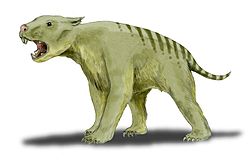| Warendja Temporal range: Late Miocene—Late Pleistocene | |
|---|---|
| Scientific classification | |
| Domain: | Eukaryota |
| Kingdom: | Animalia |
| Phylum: | Chordata |
| Class: | Mammalia |
| Infraclass: | Marsupialia |
| Order: | Diprotodontia |
| Family: | Vombatidae |
| Genus: | † Warendja Hope and Wilkinson, 1982 |
| Species | |
| |
Warendja is an extinct genus of wombat. It is known from two species, W. encorensis from the Late Miocene Riversleigh site in Queensland, [1] and W. wakefieldi known from the Pleistocene of South Australia, New South Wales, [2] and Victoria. [3] The two species are primarily distinguished by features of their enamel. [1] It became extinct as part of the Quaternary extinction event. [3] [2] [4] [5] [6] Warendja wakefieldi is estimated to have weighed about 10 kg, considerably smaller than living wombats. [7] Warendja thought to be relatively basal amongst wombats, [8] being the most primitive member to possess hypselodont (high crowned) cheek teeth. The morphology of the humerus of W. wakefieldi suggests that it engaged in scratch-digging. [9]

